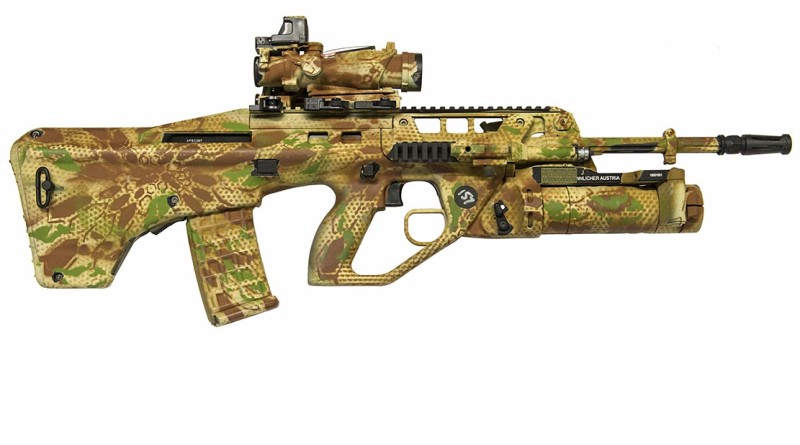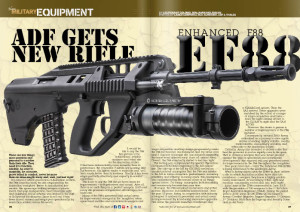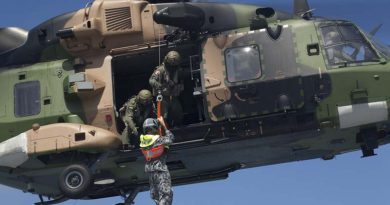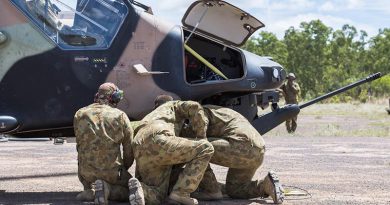New EF88 assault rifle examined

There are few things more precious and personal to a soldier than their rifle. They need it to function reliably, be easy to maintain, be accurate, prove lethal in combat, never be more than an arms-length away and, well, just feel ‘right’.
For almost a whole generation of Australian soldiers, the F88 Steyr has been the rifle employed by the Australian warfighter. Before its introduction into service, this space-age-looking weapon of plastic, metal, bull-pup configuration, fixed telescopic sight and enigmatic colour scheme was limited to the stuff of Hollywood blockbusters. Since its roll out, it has been issued, carried and employed operationally by Australian soldiers across the world.
It would be fair to say the F88 has proven to be a functional, reliable, accurate and lethal rifle for the Australian soldier. It has been demonstrably more accurate than its predecessor, the venerable 7.62mm Self Loading Rifle. Furthermore, it is lighter, easier to maintain and, well, ‘feels much better’ than its forebear. Finally, it has been employed both effectively and expertly in combat operations.
This is not to say the F88 did not have areas for improvement – both perceived and actual. After all, there is no such thing as a ‘perfect’ weapon. Each and every rifle possesses comparative advantages and trade-offs.
Many of the F88’s perceived and actual areas for improvement emerged in the ‘noughties’ when operational realities and evolutions in weapon and target acquisition ancillary design progressively made the F88 feel heavier, less balanced and, by virtue of its fixed 1.5-power telescopic site, less accurate (arguably, this same trend affected most, if not all, assault rifles). Overall, the F88 eventually started to feel less ‘right’.
This feeling was compounded by Special Operations Command (SOCOMD) migrating to the M4 assault rifle. The take-up of the M4 by SOCOMD fuelled an unsubstantiated assumption that the F88 was inferior to the M4 in terms of function, performance, accuracy, reliability and lethality. In many cases, this assumption was exacerbated by the natural allure of all things ‘special forces’. For many, assumption both invariably and erroneously became fact over time.
Read the rest of this story in CONTACT Air Land & Sea –
our FREE military e-magazine…
EARLIER NEWS:
Defence has signed $100-million contract for new rifles
EF88 delivery steps closer.
.
.
.
.
.
.

.
.







The ADF’s WTSS is a training system. It is the step between dry-firing and live firing. Soldiers can get a LOT of practice on this half-way step to square-away most of their weapon-handling drills, application of the Marksmanship Principles and even giving and responding to target indications and fire-control orders. Of course, it cannot (and does not claim to) replicate TOTALLY, live-fire conditions.
20 live rounds are better than 100 simulator rounds, which are better that 1000 dry-fired trigger-pulls (IMHO). And all are better than no training.
I’m “Old time”, I “qualled” in 7.62 SLR, M16 and Browning 9mm, we also occasionally trained with GPMG M60, and 7.62 Bren Gun. I’ve also fired F1, CG, M79, 7.62 Parker-hale and trained with M26, and Rock ( a Training substitute for M26) I have handled the F88, and compared to the M16, of which the M4 is related, the F88 feels like two Bricks, balance is just strange, as compared to the M16 one Brick. Compact is good, and exhaustion is worse, however to be able to hit a target behind a tree, is better than to have you shot deflected by a piece of grass. Maybe an F88 with 7.62 round, better balance, and weight considerations improvements?
The M4 has had a few round updates in the US to overcome its shortfall. a 6mm, 6.5mm and a 6.8mm round has been tried, same actions required just larger rounds and they all worked better. Personally, I would like to see a 7.62 in every section for those out of 5.56 effective range.
When I first joined all the old timers were on about ‘ya can’t beat the old free oh’ and would say ‘you cannot beat the SLUR for knocking down power’. I became like them!!
As an Airfield Defence Guard in the RAAF 1970’s we were lucky once a year to fire about 60 rounds SLR, 100 rounds (one link belt) GPMG M60 and a hand grenade once a year.. and also 20mm M78 ?? (87 ??) about 5 of those rounds.. I never ever go to be a good shot – nor did I consider my self trained enough in combat due to near total lack of Practice. Yes it was a labor Government – they never liked to spend much on defence.
Personal opinion – I still think we need to look at a larger calibre. 5.56mm is too small and is “out of puff” at 300 metres.
Yeah interoperability would be a pain, but why be a sheep? Is 6.8 SPC too big a jump?
If we all think the same, we’re not thinking!
George Patton.
Hi Chris. This is a very thorny subject that always comes up. There are very few soldiers who would disagree with you.
But the sad FACT is that the cheque for $100 million has already been signed, so arguing or worrying about ‘something else’ is a bit pointless, I’m afraid.
That said, there are things that can and should be discussed that can affect things that should be affected. What I’m clumsily getting around to saying is, “the art of shooting with the weapon you’ve been given is not taken seriously enough”.
That’s my opinion. What do (all of) you think?
Yes. Sounds like we’re “old School”. RAAF here in Canberra get OUT to Majura Range. Army go to the WETTS at RMC. After shooting both, I’m convinced that the art of good shooting means you’ve got to get down on your guts AND get dirty.
Light conditions for instance – Affects POI.
A WETTS is dark and the Serials don’t replicate changes in light conditions or replicate real wind ( aiming off ). This is Skill At Arms.
Arte et Marte
Absolutely.
And let me give you a little insight into where I’m coming from…
I can’t remember the years (but probably around 1998-2004 or something like that), I was a member of “The Australian Army Rifle Association” and participated in a ‘Monthly Medal’ shoot once a month on a Sunday. And, while I always fancied myself as a decent shot, my shooting improved immensely over the years.
And I learnt that there is absolutely no substitute for practice, practice, practice. Not just for aim and grouping etc, but for familiarity with your primary tool of trade.
And, unless you are in the Infantry etc, there is just simply not enough opportunity to put rounds down range in the ADF.
But, that’s the problem – it’s just too damn hard to get on a range with live rounds. And it really doesn’t need to be as hard as it is.
Hi Brian AARA and all the competition shooting we all did and was lucky for that era, I was 1988 to 1996, The F88 was not a fan and still not but looking at the F90 with a ACOG Trijicon Scope still waiting on the feed back from Soldiers but yes the SLR what a rifle that was, the rifle I think we should have got is the Colt M16A4, reports are excellent and a whole lot cheaper plus can integrate with other weapons/magazines as in the US Defence, the Colt M16A2 was geared to 600m but the A4 is out to 800m plus has the advantage of Iron Sights and various Optics
Fully agree with you Brian, the calibre of round is not always going to make the difference, it’s the calibre of the person using the weapon. Train your troops to be good marksmen and you will get the “one shot one kill” ratio. Not the 100 to 1 perhaps ratio.